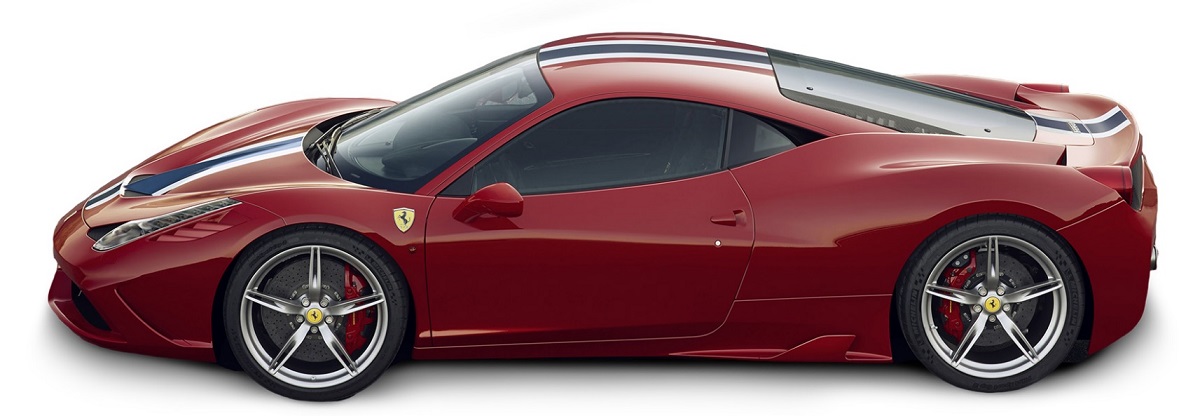

Coupe, 2 Doors, 2 Seats
11.8 l/100 km 19.93 US mpg
605 Hp @ 9000 rpm.
134.5 Hp/l
325 km/h 201.95 mph
4497 cm3
274.42 cu. in.
8, V-engine
Rear wheel drive,
4571 mm
179.96 in.
1951 mm
76.81 in.
1395 kg
3075.45 lbs.
| Brand | Ferrari |
|---|---|
| Model | 458 (Coupe) |
| Version | 458 Speciale |
| Engine version | 4.5 V8 (605 Hp) |
| Year production start | 2013 |
| Year production end | 2016 |
| Vehicle type | Coupe |
| Horsepower RPM | 605 Hp @ 9000 rpm. |
| Acceleration 0 - 100 kmh sec | 3.0 sec |
| Curb weight kg -lbs total |
1395 kg3075.45 lbs. |
| Overall length mm - inch |
4571 mm179.96 in. |
| Doors | 2 |
| Top Speed | 325 km/h 201.95 mph |
| Designation model | F136FL |
|---|---|
| Engine position and orientation | Front, Longitudinal |
| Cylinders | 8 |
| Position of cylinders | V-engine |
| Displacement (liters) |
4497 cm3274.42 cu. in. |
| Eng. horsepower RPM | 605 Hp @ 9000 rpm. |
| Horsepower per litre | 134.5 Hp/l |
| Weight / horsepower kg/hp - hp/tons |
2.3 kg/Hp433.7 Hp/tonne |
| Weight / torque kg/Nm - Nm/tons | 2.6 kg/Nm, 387.1 Nm/tonne
2.6 kg/Nm387.1 Nm/tonne |
| Torque Nm RPM lb-ft RPM |
540 Nm @ 6000 rpm.398.28 lb.-ft. @ 6000 rpm. |
| Bore (mm in) |
94 mm3.7 in. |
| Stroke (mm in) |
81 mm3.19 in. |
| Compression ratio | 14 |
| Fuel delivery system | Direct injection |
| Fuel type | Petrol (Gasoline) |
| Valvetrain | 4 |
| Engine aspiration | Naturally aspirated engine |
| Engine oil liters | quarts |
10 l10.57 US qt | 8.8 UK qt |
| Engine coolant |
16.5 l17.44 US qt | 14.52 UK qt |
| Powertrain architecture | Internal Combustion engine |
| Engine location | Front, Longitudinal |
| Drive configuration | Rear wheel drive |
|---|
| Front brakes | Ventilated discs |
|---|---|
| Rear brakes | Ventilated discs |
| Anti-lock brake system | ABS (Anti-lock braking system) |
| Steering type | Steering rack and pinion |
|---|
| Wheels size | 245/35 ZR 20; 305/30 ZR 20 |
|---|---|
| Wheels rims | 9.0J x 20; 11J x 20 |
| Passengers seats | 2 |
|---|
| Overall length mm - inch |
4571 mm179.96 in. |
|---|---|
| Overall width mm -inch |
1951 mm76.81 in. |
| Overall height mm -inch |
1203 mm47.36 in. |
| Wheelbase mm - inch |
2650 mm104.33 in. |
| Track width front mm - inch |
1679 mm66.1 in. |
| Track width rear mm - inch |
1632 mm64.25 in. |
| Curb weight kg -lbs total |
1395 kg3075.45 lbs. |
|---|---|
| Fuel tank liters | gallons |
86 l22.72 US gal | 18.92 UK gal |
| Combined l/100 km - Mpg |
11.8 l/100 km19.93 US mpg |
|---|---|
| Autonomy km (combined use) | 782 |
8 CYLINDER V-Engine
https://www.thecarspec.net/components/engine/8-cylinders-v